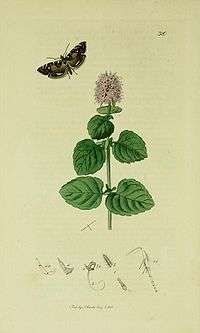Prochoreutis myllerana
| Prochoreutis myllerana | |
|---|---|
 | |
| Scientific classification | |
| Kingdom: | Animalia |
| Phylum: | Arthropoda |
| Class: | Insecta |
| Order: | Lepidoptera |
| Family: | Choreutidae |
| Genus: | Prochoreutis |
| Species: | P. myllerana |
| Binomial name | |
| Prochoreutis myllerana (Fabricius, 1794) | |
| Synonyms | |
| |
Prochoreutis myllerana, Miller’s nettle-tap, is a moth of the Choreutidae family. It is found in most of Europe, east into Russia. It is also known from China (Heilongjiang, Xinjiang), Korea and Japan (Hokkaido).[1]

Illustration from John Curtis's British Entomology Volume 6
The wingspan is 10–14 mm. Adults are on wing from May to early September. There are probably three generations per year.
The larvae feed on Scutellaria galericulata and Scutellaria minor. The young larvae mine the lower leaves of their host plant. Older larvae live free among spun leaves. There are also records on Lamium album and Lamium purpureum, but these need confirmation.
References
- ↑ "Study on Chinese Acrolepiidae and Choreutidae (Insecta: Lepidoptera)" (PDF). Retrieved 2011-12-19.
External links
This article is issued from Wikipedia - version of the 5/9/2016. The text is available under the Creative Commons Attribution/Share Alike but additional terms may apply for the media files.